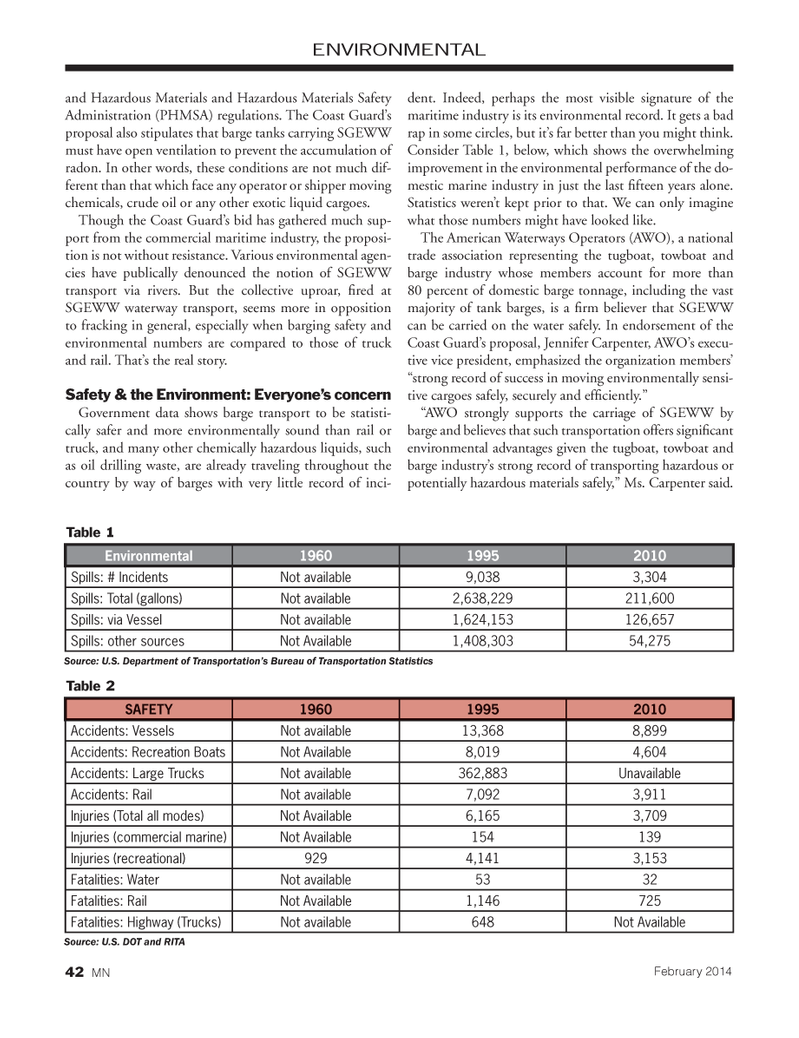
Page 42: of Marine News Magazine (February 2014)
Combat & Patrol Craft Annual
Read this page in Pdf, Flash or Html5 edition of February 2014 Marine News Magazine
ENVIRONMENTAL and Hazardous Materials and Hazardous Materials Safety Administration (PHMSA) regulations. The Coast Guard?s proposal also stipulates that barge tanks carrying SGEWW must have open ventilation to prevent the accumulation of radon. In other words, these conditions are not much dif- ferent than that which face any operator or shipper moving chemicals, crude oil or any other exotic liquid cargoes. Though the Coast Guard?s bid has gathered much sup- port from the commercial maritime industry, the proposi- tion is not without resistance. Various environmental agen- cies have publically denounced the notion of SGEWW transport via rivers. But the collective uproar, red at SGEWW waterway transport, seems more in opposition to fracking in general, especially when barging safety and environmental numbers are compared to those of truck and rail. That?s the real story. Safety & the Environment: Everyone?s concern Government data shows barge transport to be statisti- cally safer and more environmentally sound than rail or truck, and many other chemically hazardous liquids, such as oil drilling waste, are already traveling throughout the country by way of barges with very little record of inci- dent. Indeed, perhaps the most visible signature of the maritime industry is its environmental record. It gets a bad rap in some circles, but it?s far better than you might think. Consider Table 1, below, which shows the overwhelming improvement in the environmental performance of the do- mestic marine industry in just the last fteen years alone. Statistics weren?t kept prior to that. We can only imagine what those numbers might have looked like. The American Waterways Operators (AWO), a national trade association representing the tugboat, towboat and barge industry whose members account for more than 80 percent of domestic barge tonnage, including the vast majority of tank barges, is a rm believer that SGEWW can be carried on the water safely. In endorsement of the Coast Guard?s proposal, Jennifer Carpenter, AWO?s execu- tive vice president, emphasized the organization members? ?strong record of success in moving environmentally sensi- tive cargoes safely, securely and ef ciently.? ?AWO strongly supports the carriage of SGEWW by barge and believes that such transportation offers signi cant environmental advantages given the tugboat, towboat and barge industry?s strong record of transporting hazardous or potentially hazardous materials safely,? Ms. Carpenter said. Environmental 196019952010Spills: # IncidentsNot available9,0383,304Spills: Total (gallons)Not available2,638,229211,600Spills: via Vessel Not available1,624,153126,657Spills: other sources Not Available1,408,30354,275Table 1 Source: U.S. Department of Transportation?s Bureau of Transportation Statistics SAFETY196019952010Accidents: Vessels Not available13,3688,899Accidents: Recreation BoatsNot Available 8,0194,604Accidents: Large Trucks Not available362,883UnavailableAccidents: RailNot available7,0923,911Injuries (Total all modes) Not Available6,1653,709Injuries (commercial marine)Not Available 154139Injuries (recreational) 9294,1413,153Fatalities: Water Not available5332Fatalities: RailNot Available1,146725Fatalities: Highway (Trucks)Not available 648Not AvailableTable 2 Source: U.S. DOT and RITA 42 MNFebruary 2014 MN FEB14 Layout 32-49.indd 42MN FEB14 Layout 32-49.indd 421/20/2014 10:20:42 AM1/20/2014 10:20:42 AM

 41
41

 43
43
